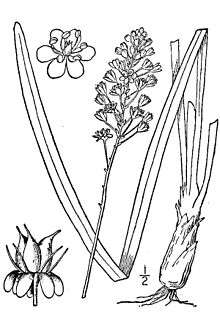Amianthium
| Fly poison | |
|---|---|
_003.jpg) | |
| in Great Smoky Mountains National Park | |
| Scientific classification | |
| Kingdom: | Plantae |
| (unranked): | Angiosperms |
| (unranked): | Monocots |
| Order: | Liliales |
| Family: | Melanthiaceae |
| Tribe: | Melanthieae |
| Genus: | Amianthium A.Gray |
| Species: | A. muscitoxicum |
| Binomial name | |
| Amianthium muscitoxicum (Wakter) A.Gray | |
| Synonyms[1] | |
|
Synonymy
| |
Amianthium is a North American genus of perennial plants growing from bulbs. It contains the single known species Amianthium muscitoxicum, known in English as fly poison from a literal translation of the Latin epithet muscitoxicum, and is noted for its pretty flowers and its toxic alkaloid content. While all parts of the plant are poisonous, the bulb is particularly toxic. The scientific epithet was given to it by Thomas Walter when he published his Flora Caroliniana in 1788.
The bulb was mixed with sugar by American colonists to kill flies.[4][5]
The toxic alkaloids present in the roots and leaves include jervine and amianthine.[4] Amianthium is self-incompatible and is pollinated mostly by beetles.[4] It is native to eastern North America, as far north as Pennsylvania, west roughly to the Appalachian Mountains (with an additional area in the Ozarks), and south to northern Florida and eastern Louisiana.[4][6]
Within the family Melanthiaceae, Amianthium is a member of the tribe Melanthieae. Molecular phylogenetic studies in the 21st century have resulted in number of changes to placements within this tribe. A. muscitoxicum has sometimes been placed in the genus Zigadenus (as Z. muscitoxicus); however its position as a separate genus is consistent with currently available information.[7] (See also Phylogeny of Melanthieae.)
Amianthium species which have been placed in other genera include:[1]
- Amianthium angustifolium A.Gray now called Stenanthium densum (Desr.) Zomlefer & Judd
- Amianthium aspericaule A.Gray) now called Triantha glutinosa (Michx.) Baker
- Amianthium leimanthoides A.Gray) now called Stenanthium densum (Desr.) Zomlefer & Judd
- Amianthium nuttallii A.Gray now called Toxicoscordion nuttallii (A.Gray) Rydb.
- Amianthium texanum (Bush) R.R.Gates now called Stenanthium densum (Desr.) Zomlefer & Judd
References
- 1 2 "WCSP". World Checklist of Selected Plant Families. Retrieved 2013-02-03. (search on Amianthium)
- ↑ Walter, Thomas 1788. Flora caroliniana : secundum systema vegetabilium perillustris Linnaei digesta; characteres essentiales naturalesve et differentias veras exhibens; cum emendationibus numerosis: descriptionum antea evulgatarum: adumbrationes stirpium plus mille continens: necnon, generibus novis non paucis, speciebus plurimis novisq. ornata 125 in Latin, as Melanthium muscaetoxicum
- ↑ International Code of Nomenclature for algae, fungi, and plants (Melbourne Code), section 60.8
- 1 2 3 4 "Amianthium". Flora of North America.
- ↑ Appalachian Wildflowers by Thomas E. Hemmerly. University of Georgia Press, ISBN 0-8203-2181-8
- ↑ Biota of North American Program 2014 county distribution map
- ↑ Zomlefer, WB; WS Judd (2002). "Resurrection of Segregates of the Polyphyletic Genus Zigadenus s.l. (Liliales: Melanthiaceae) and Resulting New Combinations". Novon 12 (2): 299–308. doi:10.2307/3392971. JSTOR 3392971.

External links
- ↑ illustration from Britton & Brown's An illustrated flora of the northern United States, Canada and the British Possessions. (1913)as Chrosperma muscitoxicum